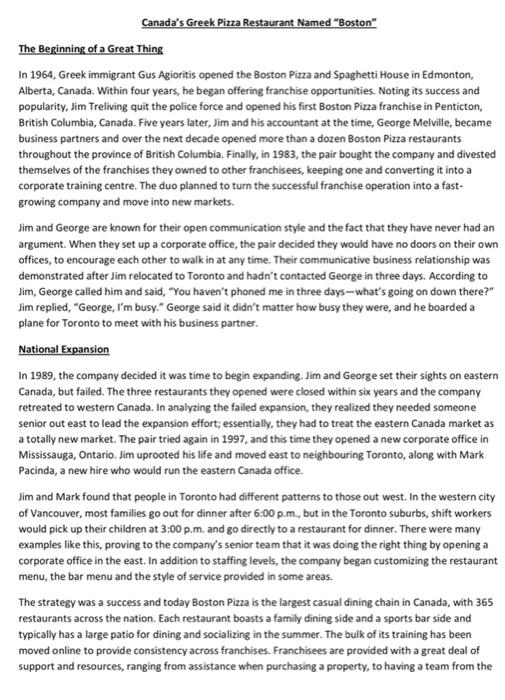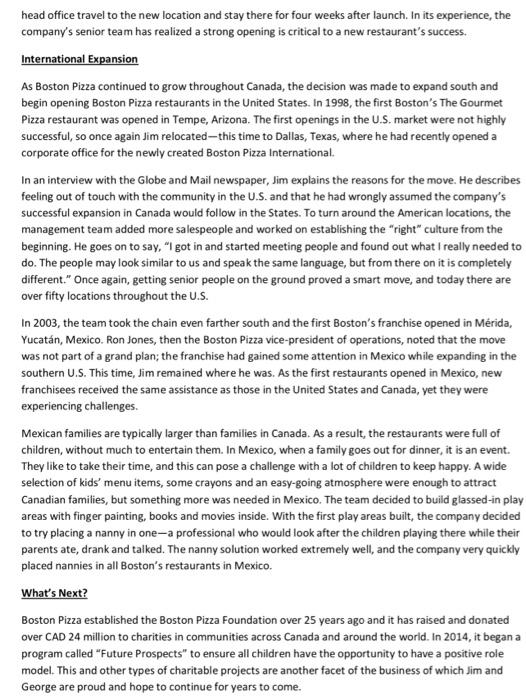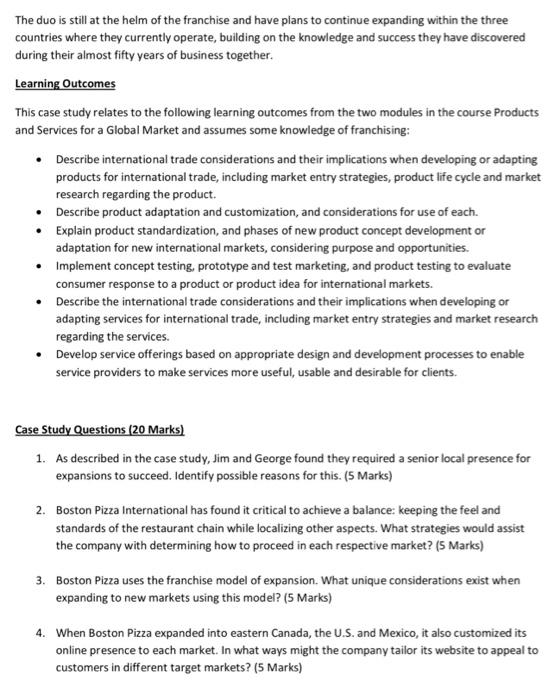Canada's Greek Pizza Restaurant Named "Boston" The Beginning of a Great Thing In 1964, Greek immigrant Gus Agioritis opened the Boston Pizza and Spaghetti House in Edmonton, Alberta, Canada. Within four years, he began offering franchise opportunities. Noting its success and popularity, Jim Treliving quit the police force and opened his first Boston Pizza franchise in Penticton, British Columbia, Canada. Five years later, Jim and his accountant at the time, George Melville, became business partners and over the next decade opened more than a dozen Boston Pizza restaurants throughout the province of British Columbia. Finally, in 1983, the pair bought the company and divested themselves of the franchises they owned to other franchisees, keeping one and converting it into a corporate training centre. The duo planned to turn the successful franchise operation into a fast- growing company and move into new markets. Jim and George are known for their open communication style and the fact that they have never had an argument. When they set up a corporate office, the pair decided they would have no doors on their own offices, to encourage each other to walk in at any time. Their communicative business relationship was demonstrated after Jim relocated to Toronto and hadn't contacted George in three days. According to Jim, George called him and said, "You haven't phoned me in three days-what's going on down there?" Jim replied, "George, I'm busy." George said it didn't matter how busy they were, and he boarded a plane for Toronto to meet with his business partner. National Expansion In 1989, the company decided it was time to begin expanding. Jim and George set their sights on eastern Canada, but failed. The three restaurants they opened were closed within six years and the company retreated to western Canada. In analyzing the failed expansion, they realized they needed someone senior out east to lead the expansion effort; essentially, they had to treat the eastern Canada market as a totally new market. The pair tried again in 1997, and this time they opened a new corporate office in Mississauga, Ontario. Jim uprooted his life and moved east to neighbouring Toronto, along with Mark Pacinda, a new hire who would run the eastern Canada office. Jim and Mark found that people in Toronto had different patterns to those out west. In the western city of Vancouver, most families go out for dinner after 6:00 p.m., but in the Toronto suburbs, shift workers would pick up their children at 3:00 p.m. and go directly to a restaurant for dinner. There were many examples like this, proving to the company's senior team that it was doing the right thing by opening a corporate office in the east. In addition to staffing levels, the company began customizing the restaurant menu, the bar menu and the style of service provided in some areas. The strategy was a success and today Boston Pizza is the largest casual dining chain in Canada, with 365 restaurants across the nation. Each restaurant boasts a family dining side and a sports bar side and typically has a large patio for dining and socializing in the summer. The bulk of its training has been moved online to provide consistency across franchises. Franchisees are provided with a great deal of support and resources, ranging from assistance when purchasing a property, to having a team from the head office travel to the new location and stay there for four weeks after launch. In its experience, the company's senior team has realized a strong opening is critical to a new restaurant's success. International Expansion As Boston Pizza continued to grow throughout Canada, the decision was made to expand south and begin opening Boston Pizza restaurants in the United States. In 1998, the first Boston's The Gourmet Pizza restaurant was opened in Tempe, Arizona. The first openings in the U.S. market were not highly successful, so once again Jim relocated--this time to Dallas, Texas, where he had recently opened a corporate office for the newly created Boston Pizza International. In an interview with the Globe and Mail newspaper, Jim explains the reasons for the move. He describes feeling out of touch with the community in the U.S. and that he had wrongly assumed the company's successful expansion in Canada would follow in the States. To turn around the American locations, the management team added more salespeople and worked on establishing the "right" culture from the beginning. He goes on to say, "I got in and started meeting people and found out what I really needed to do. The people may look similar to us and speak the same language, but from there on it is completely different." Once again, getting senior people on the ground proved a smart move, and today there are over fifty locations throughout the U.S. In 2003, the team took the chain even farther south and the first Boston's franchise opened in Merida, Yucatn, Mexico, Ron Jones, then the Boston Pizza vice-president of operations, noted that the move was not part of a grand plan; the franchise had gained some attention in Mexico while expanding in the southern U.S. This time, Jim remained where he was. As the first restaurants opened in Mexico, new franchisees received the same assistance as those in the United States and Canada, yet they were experiencing challenges. Mexican families are typically larger than families in Canada. As a result, the restaurants were full of children, without much to entertain them. In Mexico, when a family goes out for dinner, it is an event. They like to take their time, and this can pose a challenge with a lot of children to keep happy. A wide selection of kids' menu items, some crayons and an easy-going atmosphere were enough to attract Canadian families, but something more was needed in Mexico. The team decided to build glassed-in play areas with finger painting, books and movies inside. With the first play areas built, the company decided to try placing a nanny in one-a professional who would look after the children playing there while their parents ate, drank and talked. The nanny solution worked extremely well, and the company very quickly placed nannies in all Boston's restaurants in Mexico. What's Next? Boston Pizza established the Boston Pizza Foundation over 25 years ago and it has raised and donated over CAD 24 million to charities in communities across Canada and around the world. In 2014, it began a program called "Future Prospects" to ensure all children have the opportunity to have a positive role model. This and other types of charitable projects are another facet of the business of which Jim and George are proud and hope to continue for years to come. The duo is still at the helm of the franchise and have plans to continue expanding within the three countries where they currently operate, building on the knowledge and success they have discovered during their almost fifty years of business together. Learning Outcomes This case study relates to the following learning outcomes from the two modules in the course Products and Services for a Global Market and assumes some knowledge of franchising: Describe international trade considerations and their implications when developing or adapting products for international trade, including market entry strategies, product life cycle and market research regarding the product. Describe product adaptation and customization, and considerations for use of each. Explain product standardization, and phases of new product concept development or adaptation for new international markets, considering purpose and opportunities. Implement concept testing, prototype and test marketing, and product testing to evaluate consumer response to a product or product idea for international markets. Describe the international trade considerations and their implications when developing or adapting services for international trade, including market entry strategies and market research regarding the services. Develop service offerings based on appropriate design and development processes to enable service providers to make services more useful, usable and desirable for clients. Case Study Questions (20 Marks) 1. As described in the case study, Jim and George found they required a senior local presence for expansions to succeed. Identify possible reasons for this. (5 Marks) 2. Boston Pizza International has found it critical to achieve a balance: keeping the feel and standards of the restaurant chain while localizing other aspects. What strategies would assist the company with determining how to proceed in each respective market? (5 Marks) 3. Boston Pizza uses the franchise model of expansion. What unique considerations exist when expanding to new markets using this model? (5 Marks) 4. When Boston Pizza expanded into eastern Canada, the U.S. and Mexico, it also customized its online presence to each market. In what ways might the company tailor its website to appeal to customers in different target markets









